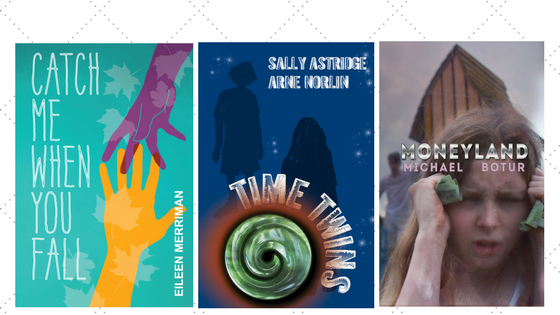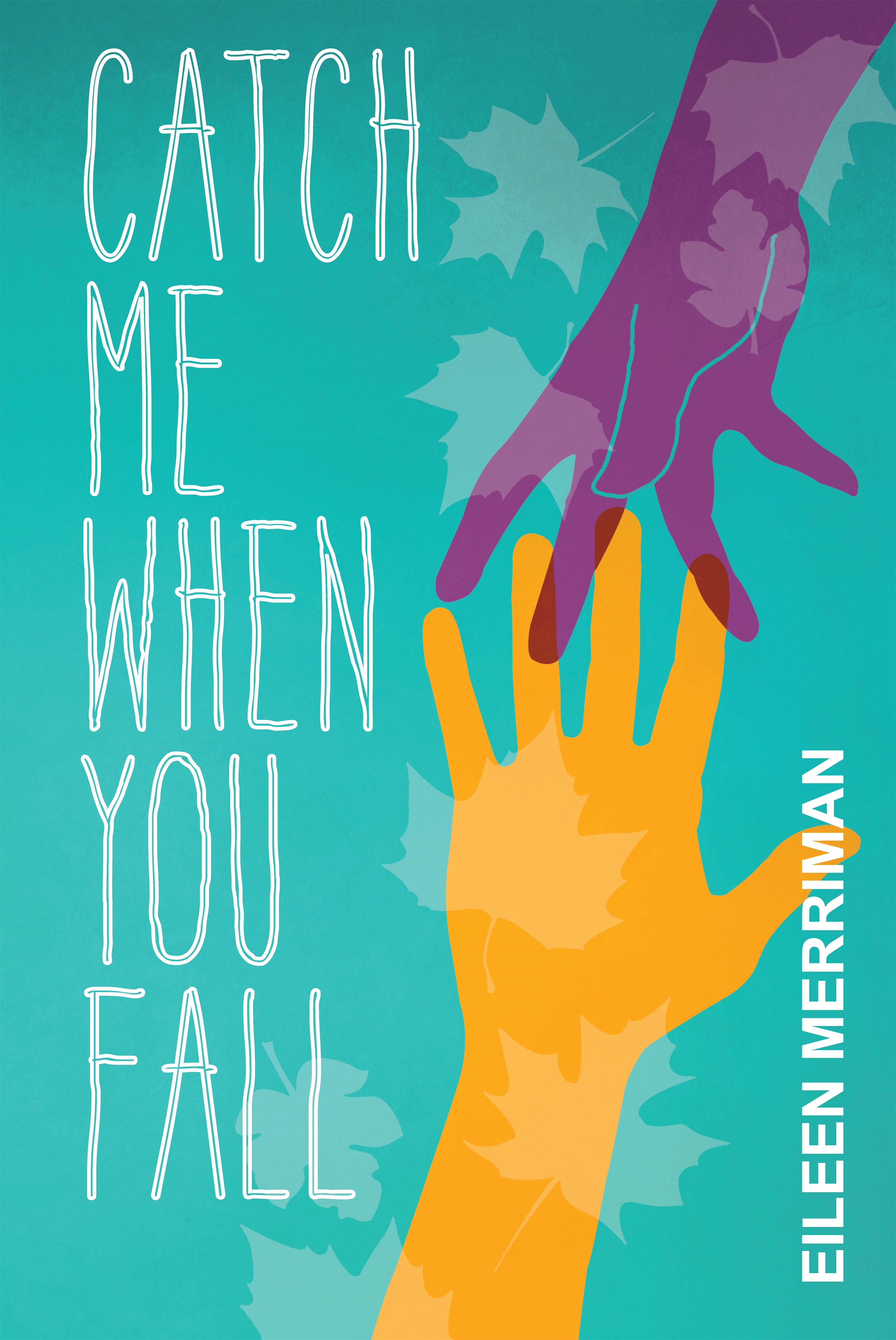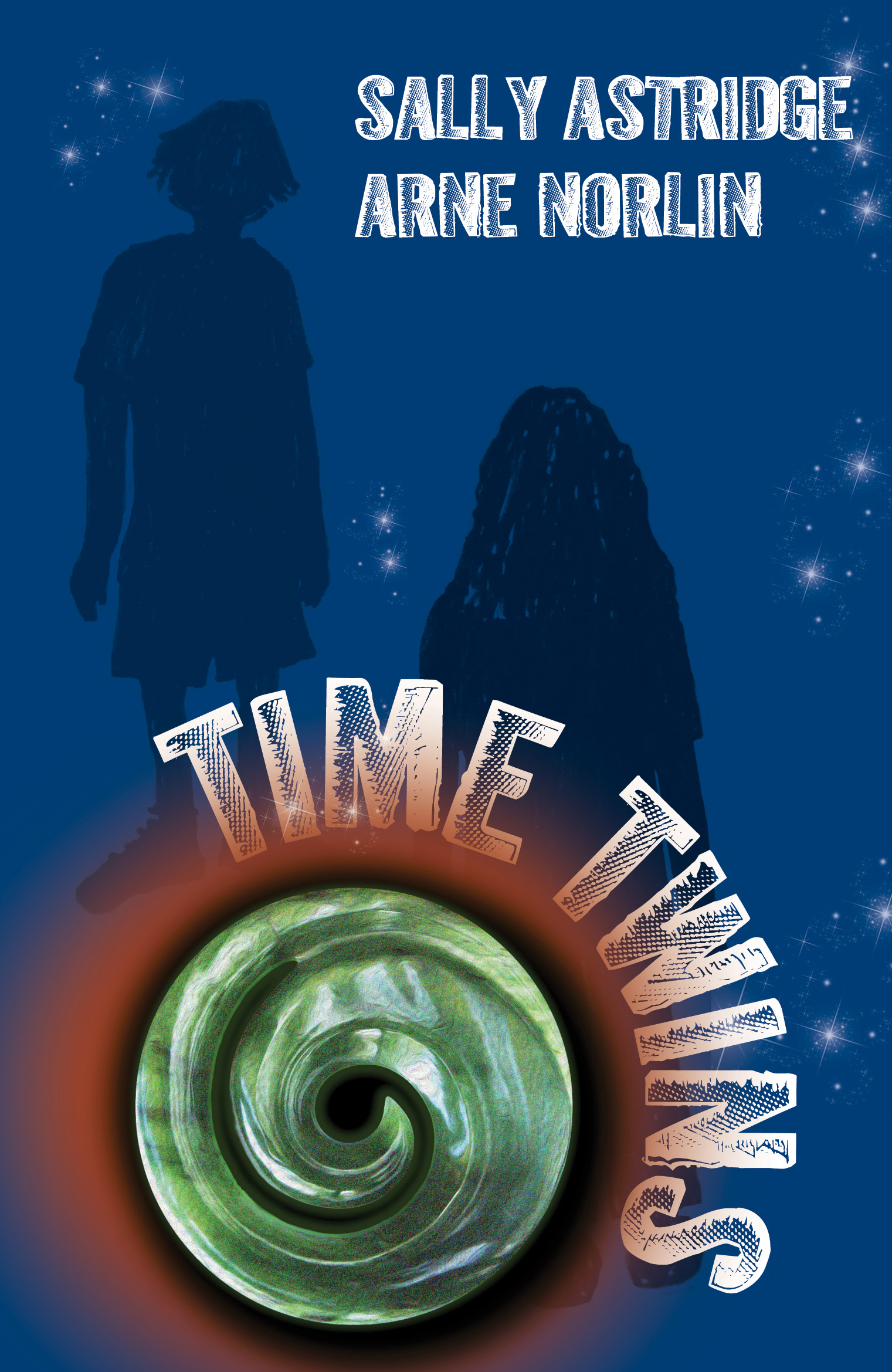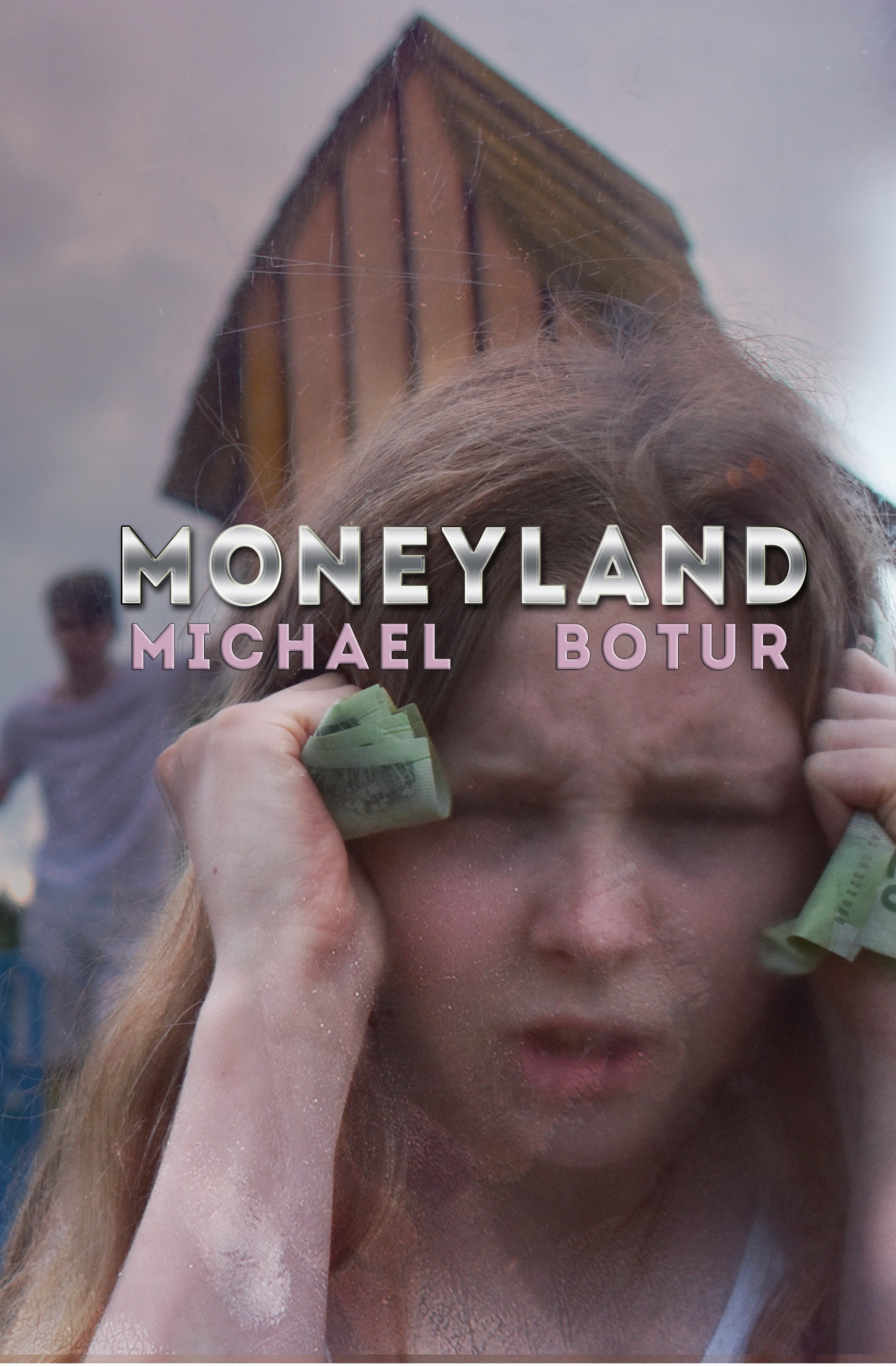One summer, so many new books. Briar Lawry reviews three fiction books which serve as a reflection of the state of the broader New Zealand middle reader and young adult fiction world.
Catch Me When You Fall is a contemporary piece that sits in the so-called ‘sick lit’ niche carved out so ably in the mainstream by John Green in The Fault In Our Stars. Time Twins is a gentle fantasy connecting characters a world apart. And Moneyland is a dystopian novel, the genre that we can never quite get enough of. The books represent a range of modern publishing endeavours. A Penguin Random House NZ title to represent the Big Six (well, Big Five these days). A Submarine title, the publisher/author co-production imprint of Mākaro Press to cover the local press space. And a self-published title, crowdfunded into printed existence. All written for teens (and/or preteens) from Aotearoa, and yet all so different.

Catch Me When You Fall, by Eileen Merriman (Penguin NZ)
Catch Me When You Fall is a thoughtful, poignant read. There’s a specific kind of fascination that comes along with a book written by an expert from a specific field translating that expertise into a fictional plot – even more so when the protagonist of the book is a young person. The author, Eileen Merriman, is a haematologist – and Alex, the 17-year-old at the centre of the book, is a leukaemia patient.
It’s not hard to feel an extra tinge of heartbreak when reading the book, thinking of all the lived experiences that will have influenced Merriman’s writing. More so than any other book I’ve read within its genre, Catch Me When You Fall doesn’t dumb things down for either the reader or the protagonist. A young woman who had leukaemia at 13 and is now having a relapse at 17 is of course going to understand all the terminology that her paediatric oncology team throw at her, rather than need things spoken in child-friendly layman’s terms. Merriman knows this. That said, there’s nothing contained within the jargon and experiences that isn’t accessible to teen readers – maybe a Google or two at moments, but what’s an online search between friends these days?
Beyond physical ramifications of Alex’s leukaemia, the book explores teenage mental health from two different, but intersecting angles. There is Alex’s struggle with dealing with her relapse, with the effects that her illness and possible premature death will have on those around her and on her own experience of the world. And then there’s Jamie – Alex’s love interest, a fellow teenager dealing with bipolar disorder.
Merriman’s medical experience manifests more explicitly in Alex’s experience on the ward, going through chemo and the waiting game of bone marrow transplant lists. Which makes sense – haematologists will be painfully familiar with leukaemia. But she also handles mental health well, observing the ongoing challenges relating to management and medication… and the treacherous paths that patients can go down if they slip up with one or the other.
Overall, Catch Me If You Fall is a great read. And above all else, it represents that wonderful integration of niche professional insight and good writing. A definite go-to for fans of The Fault In Our Stars, Me, Earl And The Dying Girl or Everything, Everything – or anything else that pulls together a bleak prognosis and an affable but agitated protagonist.

Catch Me When You Fall
By Eileen Merriman
Penguin NZ
RRP: $19.99
Read an interview with Eileen Merriman
Time Twins, by Sally Astridge and Arne Norlin
Time Twins is a relatively unusual thing in the junior fiction realm – a novel with two authors. As seems to be the way with a fair few duos writing teen fiction – for example Rachel Cohn and David Levithan, John Green and … David Levithan – there’s a perspective apiece. Kiwi author Sally Astridge writes as Tamati, a bike-riding maths-loving haggis-hating boy (of Māori and Scots heritage) from the top of the South Island. And Arne Norlin takes the persona of Astrid, a Swedish girl with a talent for music and a whole lot of troublesome preteens for classmates.
This book was published in 2014 in Swedish, as Tidstvillingarna. While this is Astridge’s first novel, Norlin has published over eighty books.
The title, Time Twins, refers to the fact that Tamati and Astrid were born at precisely the same second, making them ‘time twins’ and connected across oceans and landmasses. Once Tamati learns to harness that connection, with a little help and persuasion from his koro, he appears in Astrid’s home one night – and their friendship unfolds.
While I enjoyed both takes, for much of the book the stories are self-contained and don’t intersect. The events that do hang on their connection are worthwhile reading, but they aren’t vital to the progression of the plot. Astrid and Tamati are closely connected friends, and provide inspiration and support for one another. But until near the end of the book, there is no plotline that really hinges on this ability to travel to each other’s side – they’re kind of just corporeal pen pals.
The fact that they are time twins is secondary to the character development, really – the characters seem like they would grow in similar ways, regardless.
But as a story that dances between two sides of the world, it’s a great read. While any book set in a country that is unfamiliar to the reader will provide interesting insights, there’s something especially great about getting the insights as perceived by both a true local and a true outsider. Tamati and Astrid both talk about the ways in which their lives and schools are different from the other – providing not only insight into another culture but also the ways that said culture is perceived from the outside looking in.
Time Twins is an accessible read that touches on trickier issues, especially concerning bullying at school. Astrid bears the brunt of this, with cruel kids central to the challenges going on for her throughout her part of the story. Tamati’s concerns are either fairly quickly resolved (fears of retribution from a bully’s dad), or less immediate in nature (living up to his koro’s belief that he will become a kaiārahi to his people). The Mākaro website categorises it as for 8–12 year olds – it would also be a good read for younger teens.

Moneyland, by Michael Botur
Moneyland by Michael Botur comes with an interesting concept. It’s the year 2037. Robots (or ‘mechs’) have achieved sentience and have taken over most/many jobs. But kids are still going to school and learning, and once a year, a group of 12 teens from one school is selected to take part in an experiment – a year in a closed-off environment with no outside-world access, and a prize of a million dollars each.
The semi-dystopic, speculative fiction plot has definitely got potential as a concept. There’s immediate hints of Hunger Games and Battle Royale, even if there’s no specific directive to murder. And while the setting isn’t explicitly referred to as New Zealand, for a Kiwi reader it does have a vein of familiarity, and dystopian novels for young people set in Aotearoa are certainly rarer than international counterparts. Notable dystopic teen titles by Kiwi authors, like Fleur Beale’s Juno of Taris or Karen Healey’s When We Wake aren’t explicitly set here – so something that reads as though it could be Aotearoa in a few decades is refreshing.
However, setting aside, the concept isn’t a wholly unique proposition, and the book does stumble in a few critical ways on execution.
From the outset, the protagonist (Eden) is unbearably awful. And as the book goes along, so too are all of the teenagers. All of them. Despite living in a time where their parents are struggling to keep jobs due to the mech situation, they are appallingly self-obsessed and entitled. I thought at first that the ‘nerd’ character, Adam – who everyone hates and mercilessly bullies – was going to be the sole sympathetic teen, a potential vector for the author’s own high school experience, or something along those lines? But no. Adam is ultimately the character who most stands out as being a textbook psychopath.
Then there is the book’s wording and phrasing choices – both in the world at large, the way the characters speak to each other, and Eden’s internal monologue. Some things are just slightly perplexing – like the scrambled references to food brands from both New Zealand and the USA, rather than just one country. And the generic use of the word ‘bae’ to refer to friends.
And then things get murkier.
The teens receive their million dollars apiece in the form of actual cash – a few days into their time in the experiment. Sacks of cash are dropped down on them from above – and Eden’s lands in a tree, the bag splitting on impact. Cue her scrabbling up the tree, trying to collect her bounty before anyone else can wander along and snatch it up themselves. She stuffs bundles of money in her pockets or down her shirt … and then comes the line that really gave me pause: ‘I pulled the elastic of my shorts away from my midriff, reached down and slid $10,000 against my vagina, trying not to let out the nervous pee gathering in my bladder.’
I found it really, really hard to get past a moment like that. First of all – anatomically improbable. Young people with vaginas and vulvas tend to already have complex relationships with their genitals; it doesn’t help to have incorrect terminology in a book. Second of all – does this level of explicitness really add anything to the book? I’m no prude, but being explicit for the sake of shock value, especially in a book for teens, is not my bag. There are ways of exploring sexuality without that level of brashness. This is not the only moment of this nature, but it did stand out.
A difficulty with self-published books can be the non-traditional editorial process. With traditional publishing, regardless of the size of the press, a book will go through both copyediting and broader content or heavy editing. While reasonably slick as far as proofing and copyediting goes, this book does feel as though it could have been more successful with a more fully fledged edit.
These are three very different books, with very different audiences. Catch Me If You Fall will have broad appeal to teens and tweens reading ahead of their age. Time Twins is charming and well suited to intermediate-aged kids as well as older readers looking for something fairly gentle but not cloying. Moneyland will not be everyone’s cup of tea – but for teens who are looking for something a little explosive and no-holds-barred, it may be just the ticket to get them on a reading kick.


Briar Lawry is an English teacher and writer from Tāmaki Makaurau. She worked in bookshops for years, most notably Little Unity, and judged the NZCYA Awards in 2020. She was also one of the editors of The Sapling between 2019 and 2023.



